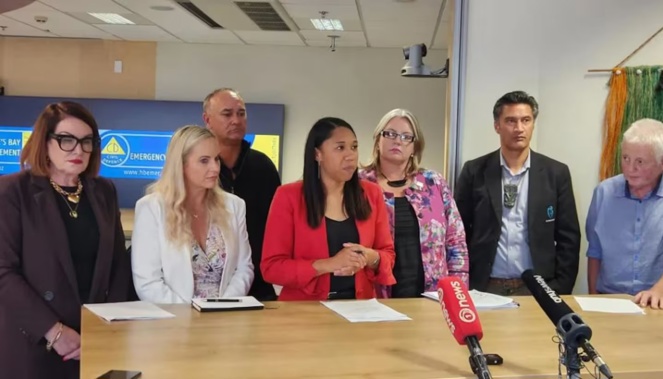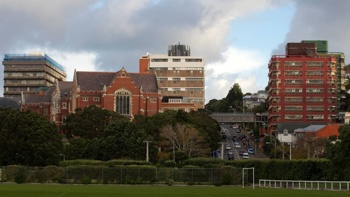
By Lauren Crimp and Adam Burns of RNZ
Some Hawke’s Bay residents remain unconvinced whether a damning report into the emergency response to Cyclone Gabrielle will amount to any meaningful change.
An independent review found the region’s Civil Defence and Emergency Management (CDEM) group was not prepared for the disaster, and the “worst-case scenario” was not planned for.
The findings and recommendations of the report, led by former police commissioner Mike Bush, were released on Monday.

The Ngāruroro River burst its banks during Cyclone Gabrielle. Photo / Dawson Bliss
The tropical cyclone, which caused widespread destruction across parts of the North Island in February last year, remains the deadliest weather event to hit New Zealand in more than 50 years.
The National Emergency Management Agency (Nema) said it had received the report and would “consider it in due course” alongside other reviews of the event, including its own report, which was still being completed.
Dan Gale lost his Eskdale caravan park business in the disaster.
He said he alerted Civil Defence on his CB radio to the rising Esk River as Gabrielle began flexing its muscles.
“The response I received on the other end was ‘We’ll pass it on’,” he said.
- Hawke's Bay emergency management committed to overhaul following Cyclone Gabrielle review
- Cyclone review: Hawke's Bay Civil Defence staff told those concerned about flooding they were 'over-reacting'
- 'It's depressing': Gabrielle still hammering kiwifruit growers
- One year on, we remember them: The 11 people who died in Cyclone Gabrielle
“I also got in touch with the [Hastings Deputy Mayor Tania Kerr] and told her people need evacuating and it got passed on in a meeting, apparently.
“The hydrologists passed the information on to Civil Defence but it just wasn’t acted upon.

Dan and Ashlee Gale with daughters Alison and Peyton. File photo / Warren Buckland
“In my opinion, it’s basically because they don’t know the heights at which point they should evacuate people.”
Some of the report findings stated that CDEM staff were overconfident about their readiness, based on previous emergency events such as Covid-19.
“They were operationally inexperienced and ‘suffered from optimism bias’ – tending to take a best-case scenario approach, rather than a precautionary approach to planning, communication and warnings,” the report said.
Another conclusion said communities, volunteers, contractors, businesses and utility providers provided “critical and heroic response activity”.
“These local resources were not well utilised by the CDEM group in the response to this event.”
Gale said recommendations from a review into the 2020 Napier floods had not been implemented and he suspected a repeat of sound suggestions and little action.
“My main concern is that it may not occur under the current staff who basically had the same suggestions put in front of them after the 2020 floods.
“I’ll believe it when I see it.”
Jayde Demanser, of Whirinaki, was similarly sceptical and said she had no faith that the region’s emergency management procedures would improve.
Jayde Demanser (right) and her husband Matt, with friend Bree Claudatos who helped with the clean up. Photo / Jayde Demanser
Demanser, who was rescued with her young family from their home when floodwaters ripped through it, said she was outraged.
“Why would our emergency management system take a best-scenario approach? Why not a proactive, prepared for the worst-case scenario, especially with the changing weather these days?
“It’s disappointing.
“I mean, lives were lost, a little 2-year-old down the road from me ... life was cut short.”
There remained no accountability for the mistakes made during the CDEM response to the disaster, she said.
“I don’t think trust can come back until someone has taken accountability, taken it on the chin, apologised, they made a mistake, someone needs to front it.
“It’s just not fair any more.”
Iwi leaders said mana whenua were largely sidelined during the initial emergency response to Gabrielle and the review echoed these sentiments.
It said CDEM’s engagement with iwi and Māori communities was “ad hoc, rather than the product of systematic and formalised effort”.
Māori agencies and marae felt their proven abilities to deliver welfare services at scale were “either ignored or hampered by bureaucratic decision-making” from the Group Emergency Co-ordination Centre (GECC).
From left, Hastings Mayor Sandra Hazlehurst, Napier Mayor Kirsten Wise, Mana Ahuriri representative Leon Symes, Hawke's Bay Regional Council chairwoman Hinewai Ormsby, Central Hawke's Bay Mayor Alex Walker, Ngāti Kahungunu chairman Bayden Barber and Wairoa Mayor Craig Little after the report's release on Monday. Photo / Anusha Bradley, RNZ
Ngāti Kahungunu chairman Bayden Barber said it was hard to get much planning cut-through with officials.
“It was all on the hoof trying to get the relationships, trying to ensure iwi and marae were part of the planning and response.
“Eventually we got to a place where we were part of the organisation, we were acknowledged for our contributions.
“But it was pushing a barrel uphill for a lot of it.”
Barber said the role of iwi should be incorporated into Civil Defence legislation.
New Zealand’s emergency management laws are being amended with a bill before the House.
One of the proposed changes is “recognising the role Māori play in emergencies and enabling Māori to participate at all levels”.
A Nema spokesperson said: “Nema is currently finalising the report of our North Island Severe Weather Event After Action review. The publication date has not yet been set but is likely to be in the next few weeks.
“The delay is due to work we have been undertaking to ensure the report identifies the causes of issues established through Nema’s self-reflections following the North Island severe weather events.
“Nema’s After Action review is not a system-wide review, rather it is a self-assessment of Nema’s response to the North Island severe weather events.”
The Government’s final report into the disaster is due to be with Emergency Management and Recovery Minister Mark Mitchell.
Take your Radio, Podcasts and Music with you









